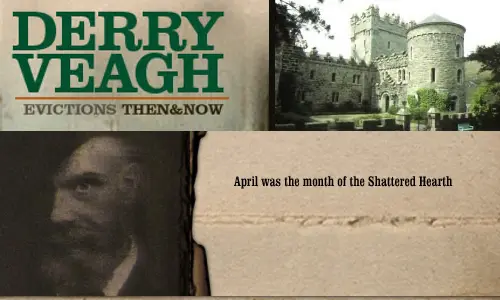The Derryveagh Evictions - Coillte remembers
The forest property of Derryveagh lies in an all but deserted and now silent valley on the foothills of the Derryveagh mountains and skirts the western shore of Gartan Lough. Plantation forestry began here in the spring of 1955 and its second rotation is now in its infancy. It is an area steeped in history for it is here that St. Colmcille was born over 1,000 years ago. More recently in the 1860’s one residents name has passed into history for a totally different reason, and that is where our story begins.
The name of John George Adair as a Donegal landlord has passed into history and folklore, ballad and documentary. All have one thing in common - Adair was notoriously cruel. He purchased Glenveagh and Gartan in 1859 making an estate of 28,000 acres.
His troubles with the tenants began almost immediately. A row between them and Adair over shooting rights and trespassing sheep culminated in the murder of his Scottish steward James Murrog. Consequently Adair carried out his threat to evict the tenancy.
On the 3rd April 1861, a considerable cortege of 200 police, three sub officers, the resident magistrate and the sub-sheriff set out from Letterkenny to undertake their duties. The evictions began at Lough Barra where a widow, Mrs Hanna McAward and her six daughters and one son were the first to suffer. The work of destruction continued for three days through Magerashangan, Staghall, Claggan, Ardator and Castletown among other townlands. In all, 44 families were evicted making a total of 244 persons. In a story recounted to me by Paddy McCormick a former member of the forest staff who planted Derryveigh in 1955, he tells the story of the end of the evictions as told to him by Dan Kelly (also forest staff now deceased) of Derryveigh. The story goes that when Adair moved out the valley he came as far as the Wards house. On entering, he discovered that the house was occupied by two ‘dummies’ (deaf mutes). “The track of the Lords hand is on this house,” he said, “and I will go no further.” That is apparently how the evictions came to an end.
Many of the evicted went to the work house in Letterkenny, others were helped by locals and the clergy also raised money. In Australia, the Donegal Relief Fund was re vitalised and arrangements were made to help the young people aged between 16 and 28 years to emigrate. Many took advantage of the scheme. As they settled in Sydney the strong oral tradition ensured that the descendents remembered their families bitter memories. One descendent, Monsignor Tony Doherty, Dean of St. Mary’s Cathedral Sydney, came to Derryveagh in 1985. He conducted a brief ceremony at the site of his grandfathers homestead in Ardatur. He told other descendants, “I found it extremely moving as I drove up to road to Churchill realising I was coming the road my People had struggled down all those years ago. It touched depths I hardly knew existed. I made the journey from Australia, a journey that concluded in a pile of stones, the remains of my grandfathers birthplace, putting me in touch with my past like nothing has ever done before.”
When the area was afforested in 1950’s the conifer plantation probably did little for those who knew, to lift the gloom and darkness associated with the area. But the people like Paddy McCormick who planted Derryveagh worked in a different time with different ‘guidelines’. They had very simple guidelines according to Paddy. Norway spruce was planted on the dry hard ground, Sitka spruce on the wet ground and lodgepole pine on poorer ground. These were the days when one man scattered the plants, the man following on planted them, you got one meal break a day and worked 48 hours a week for £3 11s 9d.
The hard work of those good men of the late fifties came to a premature end on 26th December 1998 when “Hurricane Stephen” flattened almost 100 acres of Derryveagh. As the ground lay bare following harvesting, thoughts began to stir in peoples minds. Coillte began to think of species diversity and the location suggested oak and birch (doire veagh). May McClintock of An Taisce contacted the Coillte office and expressed a wish to meet before planting began as she has huge knowledge of Derryveagh and its history and huge passion for the families of those evicted in 1861. An Taisce were looking for some oak and birch to be returned to Derryveagh and if possible they also wanted a small area set aside where people, especially the decedents could come and sit and remember in pleasant surroundings.
The area was replanted in 2000 and in all, over 20,000 Oak were planted. In consultation with Dúchas, 50 metre buffer zones were left untouched where Birch is beginning to colonise. The clear fell opened up a small blind Lough known locally as Lough Beg which is nestled softly between an escarpment of broadleaf’s on one side and the broad sweep of the sloping Derryveagh mountains on the other. It is there Coillte decided to locate the garden of remembrance, because as soon as May Mc Clintock saw it, she fell in love with it straight away. Coillte has planted Oak trees in it and the intentions are to finish up with 44 trees representing the 44 evicted families. Some preliminary work on the site has already begun. Coillte local management have committed many hours to work on the site and they are also going to provide some timber seating. The boys of the Green School Committee in Scoil Colmcille primary school in Letterkenny under the guidance of Ann McGowan, another committed environmentalist, will be involved in putting in some paths and keeping the area looking good.
According to May McClintock of An Taisce. “With the removal of the conifer plantations a whole new vista has opened up. Derryveagh has changed, oak and Birch have returned. Coillte has provided an area where descendents can come and feel at peace as new shoots appear.”
archived from: Head Office, Newtownmountkennedy, Co. Wicklow coillte.ie

